How To Create Own TRON Token In 7 Easy Steps
- BLOG
- Blockchain
- November 14, 2025
One line of code can define your project’s future. On TRON, it can shape an entire economy. What if that single line became the foundation of something people could trust, trade, and grow around? TRON’s speed, scalability, and precision give builders that power, turning ambitious ideas into real, functioning assets. But how do you build one that truly lasts? This guide breaks down how to create own TRON token step by step. Showing the strategy, structure, and execution needed to create a token engineered for performance, security, and long-term impact.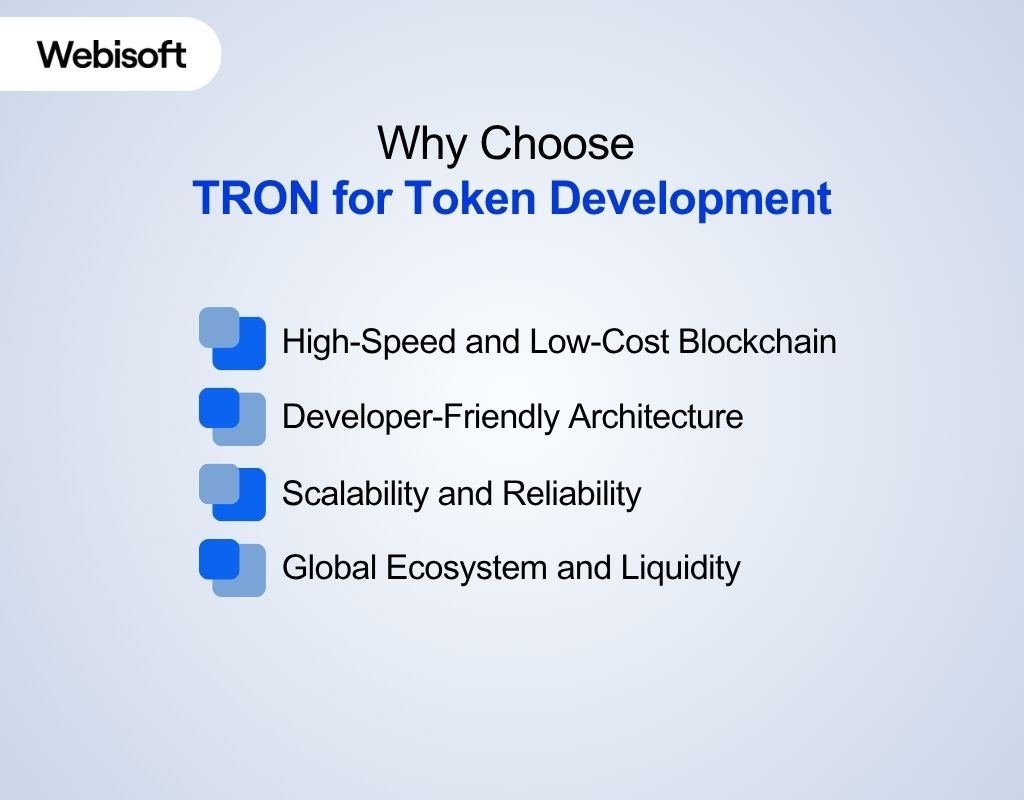 Building a token today demands more than just blockchain access, it needs performance, scale, and real-world usability. TRON delivers all three, giving creators a fast, affordable, and proven network to bring powerful digital assets to life. Here’s why TRON is the ideal choice for token development.
Building a token today demands more than just blockchain access, it needs performance, scale, and real-world usability. TRON delivers all three, giving creators a fast, affordable, and proven network to bring powerful digital assets to life. Here’s why TRON is the ideal choice for token development.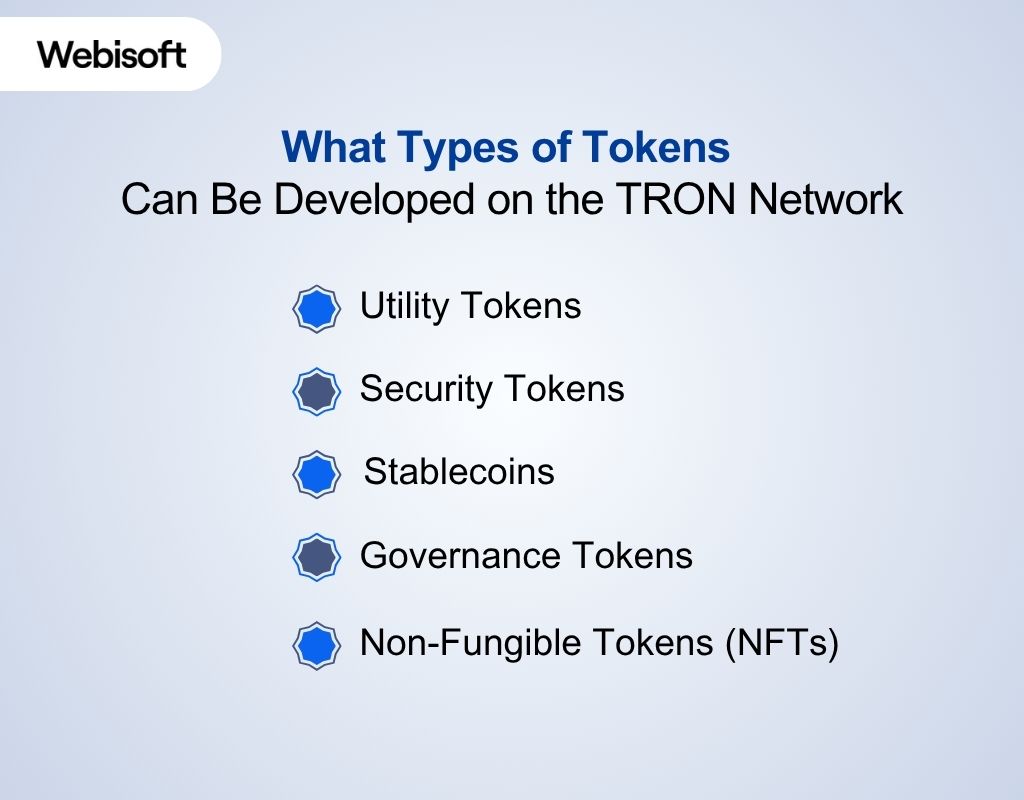 You can Categorize the TRON tokens at two levels: the blockchain level, which defines how assets are structured on the network, and the functional level, which explains what those assets are used for. At the blockchain level, TRON enables fungible tokens, non-fungible tokens, multi-asset tokens, and wrapped or synthetic assets. These categories form the technical base for every token on the network. We will talk about them in detail in the next section. The sections below focus on the functional classifications, such as utility, governance, security, and stablecoins, which describe how each token delivers value in real applications.
You can Categorize the TRON tokens at two levels: the blockchain level, which defines how assets are structured on the network, and the functional level, which explains what those assets are used for. At the blockchain level, TRON enables fungible tokens, non-fungible tokens, multi-asset tokens, and wrapped or synthetic assets. These categories form the technical base for every token on the network. We will talk about them in detail in the next section. The sections below focus on the functional classifications, such as utility, governance, security, and stablecoins, which describe how each token delivers value in real applications. Each token type on TRON follows a specific technical standard that defines how it behaves, transfers, and interacts with smart contracts. Understanding these standards is important before launching a token that aligns with your project’s purpose and scalability needs. For the most up-to-date documentation and ecosystem details, visit the official TRON Network website.
Each token type on TRON follows a specific technical standard that defines how it behaves, transfers, and interacts with smart contracts. Understanding these standards is important before launching a token that aligns with your project’s purpose and scalability needs. For the most up-to-date documentation and ecosystem details, visit the official TRON Network website.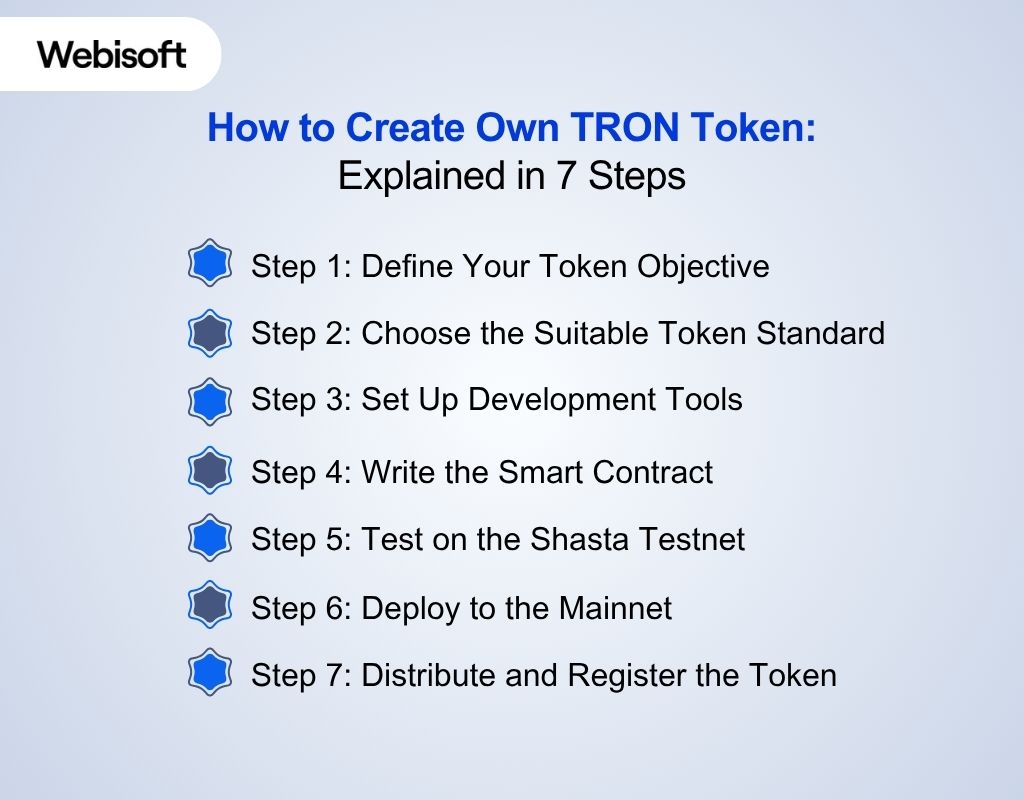 Before creating your TRON token, ensure you have the right setup: wallet, tools, testnet, and compliance. Proper preparation guarantees a smooth, secure, and efficient token development process. If you’re new, start by learning how to create a TRON wallet, it’s your gateway to deploying and managing tokens securely. Once your wallet is ready, make sure the following essentials are in place:
Before creating your TRON token, ensure you have the right setup: wallet, tools, testnet, and compliance. Proper preparation guarantees a smooth, secure, and efficient token development process. If you’re new, start by learning how to create a TRON wallet, it’s your gateway to deploying and managing tokens securely. Once your wallet is ready, make sure the following essentials are in place: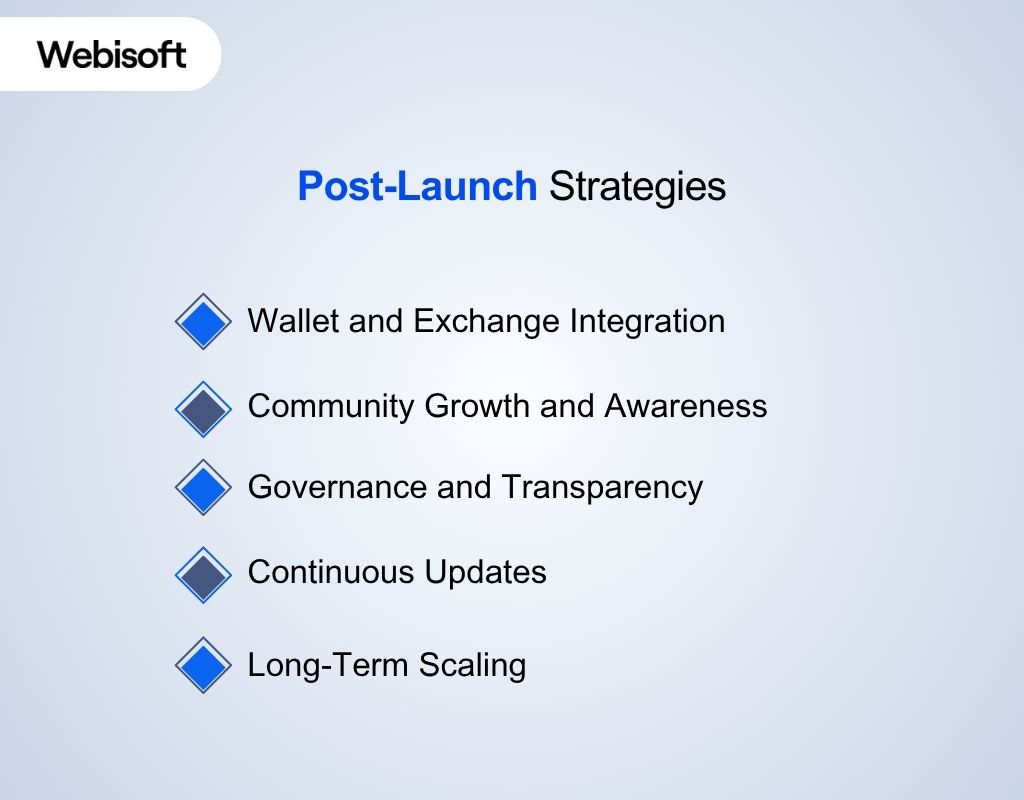 After deploying your TRON token, the focus shifts to growth and sustainability. Post-launch actions are as vital as knowing how to create own TRON token, keeping your project trusted, active, and scalable over time.
After deploying your TRON token, the focus shifts to growth and sustainability. Post-launch actions are as vital as knowing how to create own TRON token, keeping your project trusted, active, and scalable over time.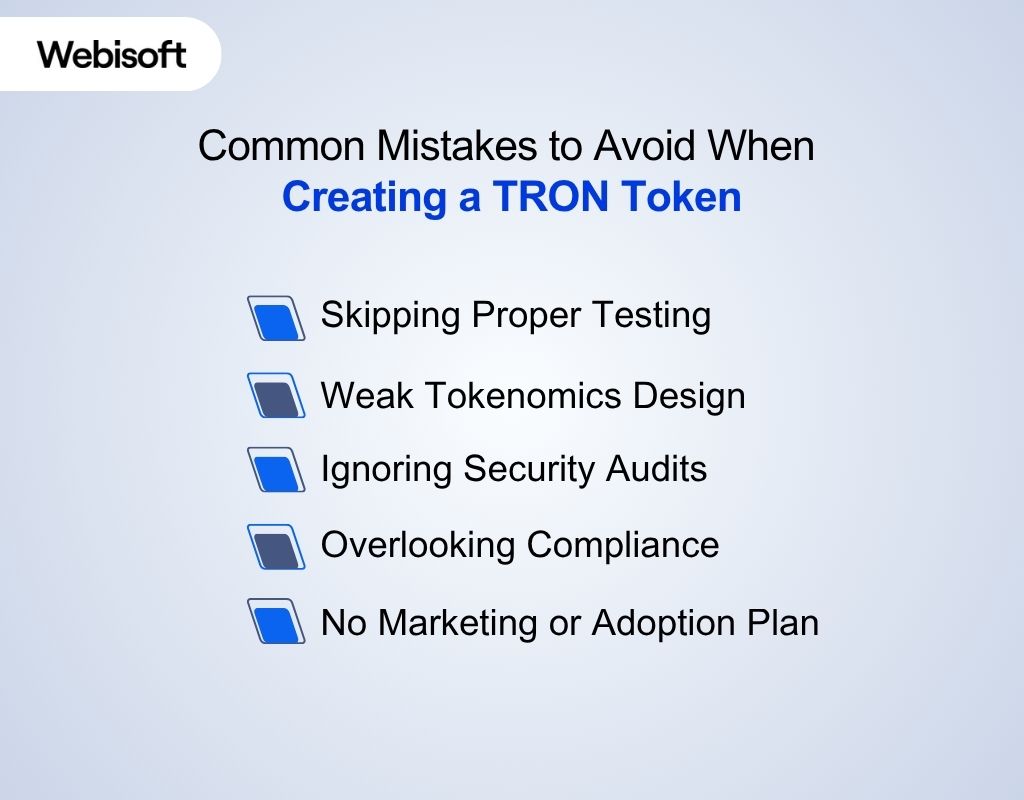 Even the most promising TRON token can fail if important steps are overlooked. Many developers rush through testing or skip compliance, only to face costly setbacks later. Understanding how to create own TRON token correctly helps avoid these pitfalls and ensures long-term project success.
Even the most promising TRON token can fail if important steps are overlooked. Many developers rush through testing or skip compliance, only to face costly setbacks later. Understanding how to create own TRON token correctly helps avoid these pitfalls and ensures long-term project success.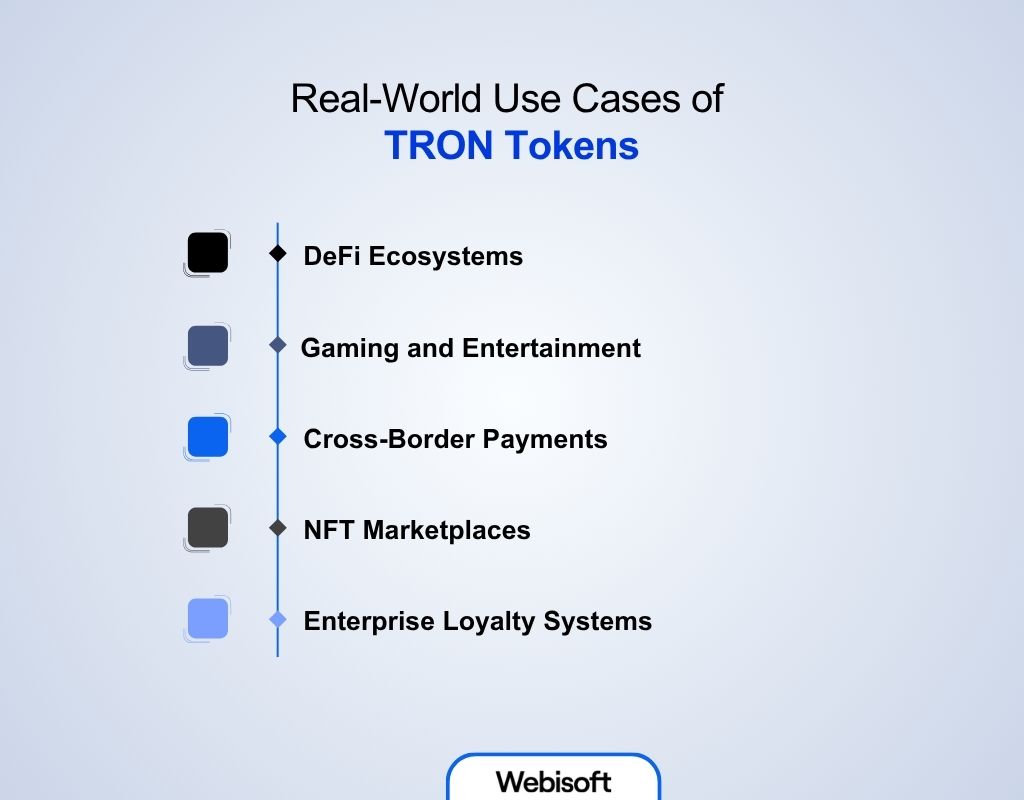 TRON’s blockchain technology extends beyond token creation, powering real-world applications across industries. From DeFi and gaming to enterprise systems, TRON tokens enable fast, secure, and low-cost digital transactions worldwide.
TRON’s blockchain technology extends beyond token creation, powering real-world applications across industries. From DeFi and gaming to enterprise systems, TRON tokens enable fast, secure, and low-cost digital transactions worldwide. In the crowded blockchain space, Webisoft stands out for one reason: precision-built solutions that deliver real results. With years of hands-on experience in blockchain, DeFi, and Web3 development, Webisoft helps teams master how to create own TRON token.
In the crowded blockchain space, Webisoft stands out for one reason: precision-built solutions that deliver real results. With years of hands-on experience in blockchain, DeFi, and Web3 development, Webisoft helps teams master how to create own TRON token.
Contents
- 1 Why Choose TRON for Token Development
- 2 What Types of Tokens Can Be Developed on the TRON Network
- 3 Build, Launch, and Scale Your TRON Token with Webisoft!
- 4 Understanding TRON Token Standards
- 5 How to Create Own TRON Token: Explained in 7 Steps
- 6 Post-Launch Strategies
- 7 Common Mistakes to Avoid When Creating a TRON Token
- 8 Real-World Use Cases of TRON Tokens
- 9 How Webisoft Simplifies TRON Token Creation
- 10 Build, Launch, and Scale Your TRON Token with Webisoft!
- 11 Conclusion
- 12 Frequently Asked Question
Why Choose TRON for Token Development
 Building a token today demands more than just blockchain access, it needs performance, scale, and real-world usability. TRON delivers all three, giving creators a fast, affordable, and proven network to bring powerful digital assets to life. Here’s why TRON is the ideal choice for token development.
Building a token today demands more than just blockchain access, it needs performance, scale, and real-world usability. TRON delivers all three, giving creators a fast, affordable, and proven network to bring powerful digital assets to life. Here’s why TRON is the ideal choice for token development.High-Speed and Low-Cost Blockchain
TRON’s high throughput allows thousands of transactions per second. Its Delegated Proof of Stake (DPoS) mechanism ensures quick confirmations and minimal energy use. Transaction fees on TRON are significantly lower compared to Ethereum, making it cost-efficient for startups and enterprises alike. And an excellent choice if you’re wondering how to create TRON token for free with minimal overhead.Developer-Friendly Architecture
TRON Virtual Machine (TVM) is compatible with Solidity, letting developers reuse existing Ethereum code. This compatibility shortens development time and reduces migration complexity for projects moving from other blockchains.Scalability and Reliability
TRON can handle large-scale dApps and token systems without congestion issues. Its performance stability has made it a preferred platform for DeFi, NFT, and gaming tokens.Global Ecosystem and Liquidity
TRON’s network supports major decentralized exchanges and wallets such as JustMoney, SunSwap, and TronLink. This extensive ecosystem simplifies integration and increases liquidity for new tokens.What Types of Tokens Can Be Developed on the TRON Network
 You can Categorize the TRON tokens at two levels: the blockchain level, which defines how assets are structured on the network, and the functional level, which explains what those assets are used for. At the blockchain level, TRON enables fungible tokens, non-fungible tokens, multi-asset tokens, and wrapped or synthetic assets. These categories form the technical base for every token on the network. We will talk about them in detail in the next section. The sections below focus on the functional classifications, such as utility, governance, security, and stablecoins, which describe how each token delivers value in real applications.
You can Categorize the TRON tokens at two levels: the blockchain level, which defines how assets are structured on the network, and the functional level, which explains what those assets are used for. At the blockchain level, TRON enables fungible tokens, non-fungible tokens, multi-asset tokens, and wrapped or synthetic assets. These categories form the technical base for every token on the network. We will talk about them in detail in the next section. The sections below focus on the functional classifications, such as utility, governance, security, and stablecoins, which describe how each token delivers value in real applications.Utility Tokens
Utility tokens enable interaction within an application or ecosystem. On TRON, they are often used in DeFi platforms, gaming apps, and marketplaces to grant access to premium features, reduce fees, or reward active participation. Their seamless integration with smart contracts makes them ideal for creating strong user engagement loops.Security Tokens
Security tokens are digital representations of ownership or equity in real-world assets like real estate, stocks, or commodities. Issued under compliance frameworks, they allow transparent ownership tracking and instant transfers on TRON’s blockchain, helping businesses create a token on TRON that’s compliant and secure.Stablecoins
Stablecoins maintain consistent value by pegging to a fiat currency such as USD or EUR. On TRON, they benefit from low transaction fees and high-speed settlements, making them suitable for remittances, payroll solutions, and cross-border payments. Projects like USDD show TRON’s strength in stablecoin infrastructure.Governance Tokens
Governance tokens empower holders to influence project direction through voting systems embedded in smart contracts. DAOs built on TRON use these tokens for decentralized decision-making, allowing transparent updates, treasury management, and protocol improvements without centralized control.Non-Fungible Tokens (NFTs)
NFTs on TRON, based on the TRC-721 standard, represent unique digital assets that cannot be replicated. They are widely adopted across art, gaming, and entertainment sectors. By using TRON’s scalability and low fees, creators can mint and trade NFTs efficiently while maintaining authenticity and ownership transparency.Build, Launch, and Scale Your TRON Token with Webisoft!
Get expert guidance from concept to deployment: secure, fast, and future-ready.
Understanding TRON Token Standards
 Each token type on TRON follows a specific technical standard that defines how it behaves, transfers, and interacts with smart contracts. Understanding these standards is important before launching a token that aligns with your project’s purpose and scalability needs. For the most up-to-date documentation and ecosystem details, visit the official TRON Network website.
Each token type on TRON follows a specific technical standard that defines how it behaves, transfers, and interacts with smart contracts. Understanding these standards is important before launching a token that aligns with your project’s purpose and scalability needs. For the most up-to-date documentation and ecosystem details, visit the official TRON Network website.TRX (Native Coin of the TRON Network)
TRX is the native currency of the TRON blockchain and the foundation of the entire ecosystem. It powers transaction fees through bandwidth and energy, enables staking for resource allocation, and secures the network via Delegated Proof of Stake (DPoS). TRX is also essential for interacting with smart contracts, paying network costs, and participating in governance. Any project building on TRON needs TRX for both development and ongoing operations.TRC-10 Standard
TRC-10 is TRON’s simplest token protocol, focused on speed and low cost. It operates natively on the blockchain without smart contracts, making it ideal for MVPs, loyalty programs, or basic payment tokens. However, its lack of automation and smart contract features limits advanced functionality.TRC-20 Standard
TRC-20 powers most of TRON’s decentralized ecosystem. Built with smart contracts, it supports minting, burning, staking, and governance. Its compatibility with Ethereum’s ERC-20 makes cross-chain migration easy. This standard fits DeFi platforms, gaming tokens, and governance systems needing automation and flexibility.TRC-721 Standard
TRC-721 is TRON’s NFT standard for unique, non-fungible assets. Each token carries distinct identifiers and metadata for ownership tracking. It’s best suited for digital art, collectibles, and gaming assets. Combined with low fees and high speed, it enables efficient large-scale NFT minting.TRC-1155 Standard
TRC-1155 is TRON’s multi-asset token standard that supports both fungible and non-fungible tokens within a single smart contract. This flexibility reduces deployment costs and simplifies management for projects requiring multiple asset types. It’s ideal for gaming systems, metaverse items, bulk minting, and platforms that issue many different assets at once. TRC-1155 streamlines large-scale asset creation while leveraging TRON’s speed and low fees.Choosing the Right Standard
Use TRX when your project needs the network’s native currency for fees, staking, and on-chain governance. Choose TRC-10 for simple, low-cost tokens without smart-contract requirements. Select TRC-20 for programmable assets that need automation, minting, or governance logic. Pick TRC-721 to represent unique digital ownership through NFTs. Choose TRC-1155 when your project must manage multiple asset types efficiently within a single contract. The right standard aligns your token’s purpose with TRON’s scalability and long-term ecosystem compatibility. For a broader perspective beyond TRON, read Webisoft’s How to Create a Blockchain Token Guide.How to Create Own TRON Token: Explained in 7 Steps
 Before creating your TRON token, ensure you have the right setup: wallet, tools, testnet, and compliance. Proper preparation guarantees a smooth, secure, and efficient token development process. If you’re new, start by learning how to create a TRON wallet, it’s your gateway to deploying and managing tokens securely. Once your wallet is ready, make sure the following essentials are in place:
Before creating your TRON token, ensure you have the right setup: wallet, tools, testnet, and compliance. Proper preparation guarantees a smooth, secure, and efficient token development process. If you’re new, start by learning how to create a TRON wallet, it’s your gateway to deploying and managing tokens securely. Once your wallet is ready, make sure the following essentials are in place:- A TRON-compatible wallet such as TronLink or Klever, funded with enough TRX to cover bandwidth and energy fees.
- A development environment using TRON-IDE or TronBox, connected to the Shasta Testnet for safe testing.
- A clearly defined token concept including purpose, target users, and use case.
- A well-structured tokenomics plan covering supply, distribution, and utility. To design a sustainable economic model, check out Webisoft’s Tokenomics Basics.
- Legal and regulatory compliance aligned with your jurisdiction’s KYC/AML requirements.
Step 1: Define Your Token Objective
Start by establishing your token’s purpose and value proposition. Determine whether it will serve as a utility token for your dApp, a governance token for decision-making, or a reward asset for community engagement. Identify your audience and define clear success metrics. This clarity will guide both technical and economic design decisions.Step 2: Choose the Suitable Token Standard
Select the right token standard for your project goals. TRC-10 works best for lightweight tokens without smart contract logic with simple transfer functions. TRC-20 supports programmable tokens with minting, burning, and staking capabilities, while TRC-721 powers NFTs for unique digital assets. Choosing the correct standard early ensures compatibility with wallets, exchanges, and your long-term roadmap.Step 3: Set Up Development Tools
Install and configure your development tools. Use TRON-IDE or TronBox for writing and compiling smart contracts. Set up TronWeb to connect your JavaScript scripts to the blockchain. Link your wallet to the Shasta Testnet and confirm it’s funded with test TRX. This environment allows you to test and debug your contract before deployment.Step 4: Write the Smart Contract
Develop your token’s smart contract using Solidity while adhering to the TRC standards. Include essential functions such as transfer, approve, mint, and burn. Add ownership permissions and event logs for security and transparency. Use official TRON documentation or verified templates as a base, and always perform manual code reviews to minimize vulnerabilities. Have a TRON token idea ready to build? Webisoft turns blockchain ideas into secure, high-performance TRON tokens, from smart contract design to mainnet launch. Connect with Webisoft and start building your TRON token today.Step 5: Test on the Shasta Testnet
Deploy your contract on the Shasta Testnet and validate all operations. Test token transfers, balance updates, and mint/burn mechanisms. Simulate multiple wallet interactions to check for performance under load. Successful testnet deployment confirms that your token functions correctly before moving to the live network.Step 6: Deploy to the Mainnet
Once testing is complete, deploy your finalized smart contract to the TRON mainnet. Ensure your wallet holds enough TRX to pay for energy and bandwidth fees. After deployment, verify your contract on TRONSCAN, making your token publicly visible and transparent. Upload the token’s metadata: name, symbol, and total supply for official registration.Step 7: Distribute and Register the Token
After the mainnet deployment, start distributing your tokens. This can include airdrops, private sales, or integration with your platform’s ecosystem. Add support in TRON wallets such as TronLink and TokenPocket, and submit listings to DEXs like SunSwap or JustMoney. Finally, verify and register your token details on TRONSCAN to build legitimacy and visibility across the network.Post-Launch Strategies
 After deploying your TRON token, the focus shifts to growth and sustainability. Post-launch actions are as vital as knowing how to create own TRON token, keeping your project trusted, active, and scalable over time.
After deploying your TRON token, the focus shifts to growth and sustainability. Post-launch actions are as vital as knowing how to create own TRON token, keeping your project trusted, active, and scalable over time.Wallet and Exchange Integration
Ensure your token is accessible across major For DEX exposure, add liquidity on platforms like SunSwap or JustMoney instead of applying for a listing. Broader accessibility increases trading volume and community participation.Community Growth and Awareness
Promote your token through awareness campaigns, airdrops, and partnerships. Stay active on Telegram, Discord, and X (Twitter) to engage your audience. Transparent updates and consistent interaction build credibility and encourage organic growth.Governance and Transparency
If your token supports governance, implement a clear voting system that lets holders propose and vote on upgrades. Share results publicly on-chain to strengthen community trust and decentralized decision-making.Continuous Updates
Keep your project evolving. Conduct security audits, patch vulnerabilities, and introduce new features such as staking or dApp integration. Consistent improvements show reliability and maintain long-term interest.Long-Term Scaling
Prepare your token for multi-chain expansion. Use cross-chain bridges to link with Ethereum or BNB Chain for higher liquidity and wider reach. Plan for scalability to ensure your token remains efficient and relevant.Common Mistakes to Avoid When Creating a TRON Token
 Even the most promising TRON token can fail if important steps are overlooked. Many developers rush through testing or skip compliance, only to face costly setbacks later. Understanding how to create own TRON token correctly helps avoid these pitfalls and ensures long-term project success.
Even the most promising TRON token can fail if important steps are overlooked. Many developers rush through testing or skip compliance, only to face costly setbacks later. Understanding how to create own TRON token correctly helps avoid these pitfalls and ensures long-term project success.Skipping Proper Testing
Launching without testnet validation can cause irreversible errors. Always test thoroughly on the Shasta Testnet to ensure transfers, balances, and ownership functions work correctly before mainnet deployment.Weak Tokenomics Design
Unclear or unbalanced tokenomics damages market confidence. Define transparent supply limits, fair distribution, and vesting schedules aligned with your project’s goals to maintain value stability and trust.Ignoring Security Audits
Smart contract vulnerabilities can lead to major financial losses. Conduct third-party audits to detect and fix flaws before deployment, ensuring your contract is secure and reliable.Overlooking Compliance
Failing to classify your token properly invites regulatory risk. Confirm whether your asset is a utility, governance, or security token, and follow KYC/AML rules to stay compliant.No Marketing or Adoption Plan
Even the best token fails without exposure. Develop a clear marketing and community strategy that includes pre-launch campaigns, partnerships, and consistent engagement to build awareness and adoption.Real-World Use Cases of TRON Tokens
 TRON’s blockchain technology extends beyond token creation, powering real-world applications across industries. From DeFi and gaming to enterprise systems, TRON tokens enable fast, secure, and low-cost digital transactions worldwide.
TRON’s blockchain technology extends beyond token creation, powering real-world applications across industries. From DeFi and gaming to enterprise systems, TRON tokens enable fast, secure, and low-cost digital transactions worldwide.DeFi Ecosystems
TRON’s low fees and scalability make it ideal for decentralized finance. Platforms like JustLend and Sun.io use TRC-20 tokens for lending, staking, and governance. Stablecoins such as USDD maintain liquidity and stability, helping DeFi protocols operate efficiently with minimal transaction costs.Gaming and Entertainment
Games on TRON utilize TRC-20 tokens for in-game currencies and TRC-721 NFTs for collectibles. Projects like WINkLink combine gaming and DeFi, letting players earn, trade, and stake digital assets within a secure blockchain ecosystem.Cross-Border Payments
TRON-based stablecoins, including USDD and USDT-TRON, are redefining global payments. They offer near-instant, low-cost transactions, making TRON a preferred network for remittances and international business transfers.NFT Marketplaces
With the TRC-721 standard, TRON supports large-scale NFT trading on platforms like ApeNFT. Artists can mint, sell, and verify ownership directly on-chain, benefiting from fast transactions and minimal gas fees.Enterprise Loyalty Systems
Businesses use TRC-10 tokens to create blockchain-based loyalty programs. These tokens simplify customer rewards, ensure transparency, and eliminate fraud, offering a reliable solution for digital incentive systems.How Webisoft Simplifies TRON Token Creation
 In the crowded blockchain space, Webisoft stands out for one reason: precision-built solutions that deliver real results. With years of hands-on experience in blockchain, DeFi, and Web3 development, Webisoft helps teams master how to create own TRON token.
In the crowded blockchain space, Webisoft stands out for one reason: precision-built solutions that deliver real results. With years of hands-on experience in blockchain, DeFi, and Web3 development, Webisoft helps teams master how to create own TRON token. Comprehensive Token Development
Webisoft approaches every project with a mix of technical depth and strategic clarity. The team helps you shape your tokenomics, validate your business logic, and design the ideal smart contract architecture. From planning to deployment, Webisoft ensures your TRON token is not just functional but future-ready, combining reliability with real-world performance.Customized TRC-10 and TRC-20 Solutions
No two projects are alike and Webisoft builds accordingly. For lightweight use cases such as loyalty systems or basic utilities, the team develops fast, efficient TRC-10 tokens. For complex ecosystems like DeFi platforms or governance models, Webisoft creates fully programmable TRC-20 tokens with advanced smart contract logic. This adaptability makes it the ideal partner for startups and enterprises alike.Smart Contract Security and Auditing
Webisoft’s development workflow prioritizes security above all. Every token undergoes multi-layer auditing, including vulnerability scans, manual code reviews, and performance testing under simulated network stress. These checks eliminate exploitable flaws and ensure your TRON token operates securely, even under heavy use.Integration and Launch Support
A smooth launch defines project success. Webisoft assists with wallet compatibility, dApp integration, and DEX listings on networks like SunSwap and JustMoney. The team also coordinates launch strategies to generate early visibility and adoption, ensuring your token gains traction from day one.Ongoing Maintenance and Scaling
Webisoft’s support continues long after deployment. They monitor token performance, apply updates aligned with TRON’s latest upgrades, and enable multi-chain scaling across various ecosystems. With continuous maintenance and optimization, your token remains relevant, secure, and adaptable as the blockchain space changes.Build, Launch, and Scale Your TRON Token with Webisoft!
Get expert guidance from concept to deployment: secure, fast, and future-ready.


